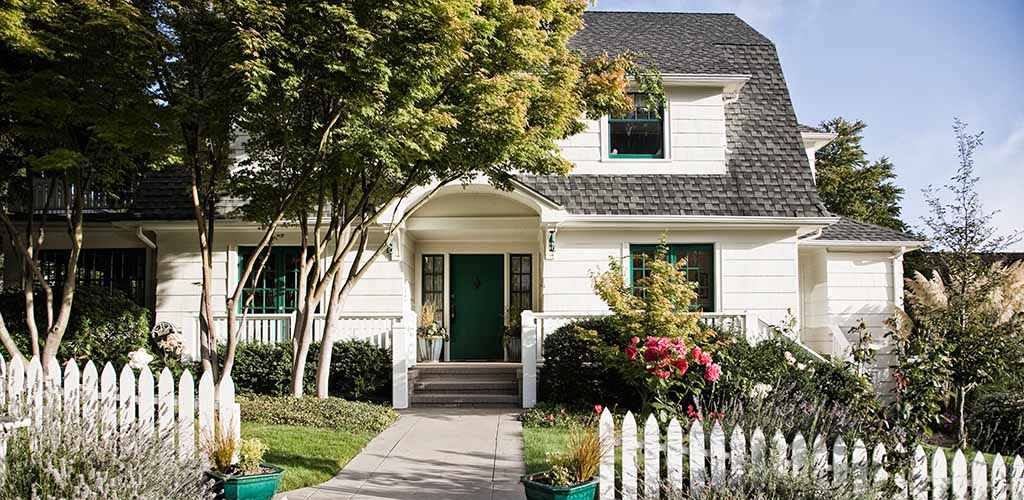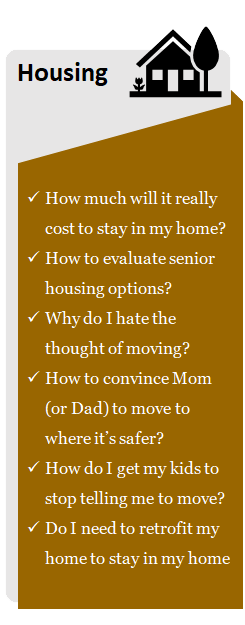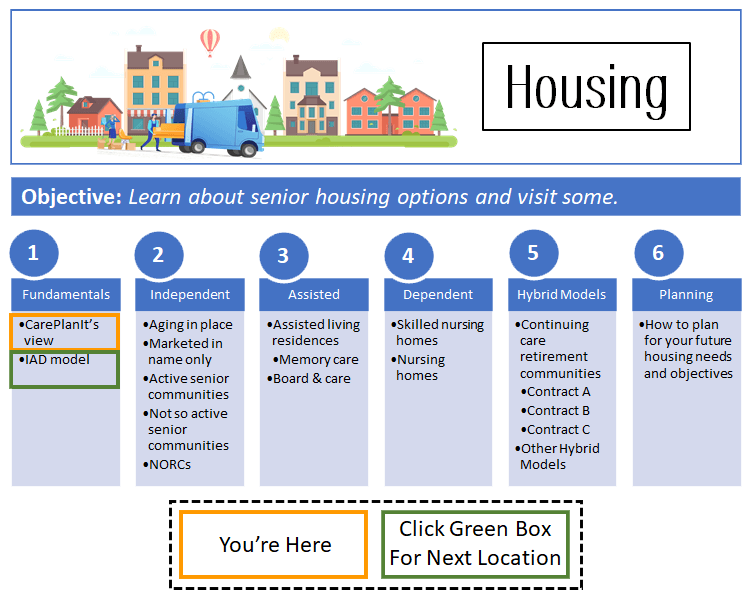It’s Your Little House On The Prairie
Click here to see what's on this page.
Seniors’ number one age-related concern is staying in their own homes. Whether it’s a little house on the prairie, a condo, a farm, a brownstone, a townhome, a doublewide, or an apartment, your home is sacred. Whether your style is ranch, craftsman, cape cod, or cottage, it’s where you want to stay. We’ll show you how to increase the odds of living out your years in your little house on the prairie, or wherever your home may be.

Many of the reasons we’re forced from our homes as we age are the same confronting Charles and Caroline Ingalls. Injuries, money problems, fires, illness, and family far away were factors that affected the Ingalls family and factors that affect us today when it comes to our ability to stay in our homes.
Seniors’ Number One Aging Concern Is Having To Leave Their Home
Americans are strongly attached to their homes. This occurs for many reasons. People associate their home with family, community, and security. The key point is that our homes are not just physical places. They are emotional attachments that dramatically impact how we view ourselves, and in turn, how we view aging. Simply put, American seniors don’t like leaving their homes for an alternative housing option.
Famous Quotes About Our Home
“There’s no place like home, there’s no place like home, there’s no place like home.”
“You are a king by your own fireside, as much as any monarch in his throne.”
“Home, the spot of earth supremely blest, A dearer, sweeter spot than all the rest.”
When we’re comfortable in our own home, we don’t want to move. Almost everyone over seventy-five is comfortable in their home. Home is home, whether it’s a mobile home, apartment above our kid’s garage, rental, condo, house, mansion, or island.

For seniors, it’s all about housing. Every study on seniors shows that seniors want to stay in their own homes more than anything. If these seniors live long enough, over 80% will spend their last years somewhere else.
Super Agers, stay in their own home because they understood their abilities and planned accordingly. They knew how to match their home with their needs.
CarePlanIt shares what Super Agers know. By learning the Master Housing Technique, you can too.
Reasons Why Seniors Are Forced To Move Out Of Their Little House On The Prairie
Carmen and I heard hundreds of stories about Agers falling downstairs, slipping in bathrooms, and injuring themselves doing home maintenance. The injured Ager usually thought nothing of it (or at least didn’t express any concern); whereas family members viewed these injuries as catastrophic events. Family members often said things like “Our parents’ home is too much. It’s not safe.” Agers often tried to hide injuries from their family. When family members discovered the injury, Ager’s said things like, “Younger people have accidents too. We love our home, and we’re not moving.” We discuss issues of home maintenance here. We discuss making your home safer to minimize injuries here.
Factors Allowing You To Stay In Your Home
Carmen and I thought a lot about what was going on between Agers and their home; and how this relationship was impacting concerns of family members, caregivers, and doctors. We wondered if we could create a kind of rule of thumb, geometric axiom, or equation. We started observing and asking seniors how they viewed their ability to stay in their own home. Seniors’ comments fell into two commonly mentioned categories, and one implied category.
These were health, money, and risk. The same factors affecting Charles and Laura Ingalls in Little House on the Prairie. Today we have technology, government programs, and community services that can help us mitigate many of these concerns.
The Health Factor
The two common categories were health and money. We met a few seniors that were remarkably healthy even in advanced old age. They hiked, biked, and worked. They did their own home repairs. When I asked them about their housing aspirations, they looked at me like I had three heads. “Why would I live anywhere else?” These super healthy seniors were not rich or financially well off. They simply had great health.
The Money Factor
The other common category was money (or resources). The wealthy seniors we met didn’t have any concerns about housing. At least not the concerns you and I might have. When we asked wealthy seniors if they thought they could stay in their homes forever, they said: “Of course we can.”
When we asked about the possibility of them becoming bedridden or needing nursing care, they were able to point to situations where they or their family members simply brought the help they needed into their home. One man showed me the hospital room he set up for his spouse. “There’s better equipment here than the hospital,” he proudly said. He also was using foreign doctors as caregivers.
Money simply allows you to purchase services (resources from others). Carmen and I met seniors that were not rich but had family members that provided similar services the very wealthy purchased. One woman we met was able to get help from her children. Two moved into her home. One was a nurse that could help with medical care. The other managed the household. He did the shopping, prepared the meals, and did all the housework.
The Risk Factor
Finally, there was the “implied” element that no one voiced but was evident whenever an Ager and their child had a discussion around their parent’s home. I never truly understood the issue until it smacked me in the brain while I was hiking in Northern New Mexico below an area called REACH.
REACH is a community of Earthships (passive solar homes built from natural and upcycled materials like tires, glass, and sand) built onto a mountainside 7,000 feet high.
You can’t drive to these homes; they are embedded in the mountain and don’t have road access. Earthships in REACH are on 30 – 40-degree slopes. I saw an elderly man hiking up the hill to one of the Earthships. “Was this his home?” I wondered.
The homes themselves have lots of stairwells, levels, and cubby holes. They’re kids dream homes. Some adults have the same dream. At this elevation, high in the mountains, with terrible roads covered by ice and snow, it occurred to me that many seniors were willing to take on huge risks to live in their homes. I never caught up with the man to see if he actually lived at REACH.
Seniors Take On Huge Risks To Stay Home
When Carmen and I returned to Nashville, Tennessee we went to an estate sale. The sale was being held by the children of a 90-year-old woman. She was leaving her home of forty years. We were scouring her house, looking for treasures. It was two stories with a built-out basement that housed her washer and dryer. The mother had her bedroom upstairs. We asked the son why his mother was moving. “She fell down the basement stairs,” he said. “Twice she fell down those steps.”
That’s when I realized that all seniors were taking on risks to live at home. These risks were not just for seniors living on the sides of mountains. They were not just for seniors living in three-story homes. I realized that a senior with mobility problems that stayed in their home may have the same risk profile using the bathroom as a healthier senior descending stairs. Every senior faces some element of risk. All things being equal, the healthier the senior, the lower the risk. But as seniors age, the risks grow.
We may not live in little houses on the prairie anymore, but the risks we took on when we did haven’t gone away.
The Stay In My House Equation
These three factors became the right side of our housing equation. Your ability to stay in your home is a function of Health, Money, and Risk.

To recap the factors of this equation:
Health Effects On Staying In Our Home
The healthier you are, the easier it is to stay in your own home. Any home. If you’re in perfect health, you can do all your own repairs and maintenance. If your healthy, even if you never did a home repair in your life, you can learn to make the repair. That’s the advantage of perfect health. As your health declines, you need to rely more on the other two factors.
Charles & Laura Ingalls Almost Lose Their Home Over Health Issues
In the first episode of Little House on The Prairie, Charles’s dream of building his homestead almost comes to an end after he’s injured falling from a tree. But the community of Walnut Grove comes to his rescue.
Money Affects On Staying In Our Home
Money or resources represent your ability to transform your home into an environment that can accommodate your health. Need assistance, with enough money or resources, you can convert your home into an assisted living facility. Need skilled nursing assistance, with enough money, you can turn your home into a skilled nursing facility.
Charles and Laura Ingalls Almost Lose Their Home Over Money Issues
In episode eighteen of season four of Little House on The Prairie, Charles and Laura learn of a large inheritance. They believe they’re rich, They become spendthrifts helping others with money they don’t yet have and wasting money on unnecessary things. Ultimately they learn their inheritance is really nothing. On their farm, a lienholder on their little house on the prairie threatens to foreclose.
Risk Affects On Staying In Our Home
Risk is what you take on when you are short on health and money. As your money and health decline, and you choose to stay in your home, the risks you are taking on go up. If I have money, but am weak or sick, I can pay someone to do my laundry, help with housework, and help me bathe.
A hundred years ago, lots of us lived in little houses on the prairie or a variation like a farm. When we got older, we had family move in with us, usually our oldest son. That mitigated risk. Today this is a rare scenario.
It is the “Risk” factor that Agers and their families most often fail to reconcile. The children of Agers don’t think of their parents as risk takers, or don’t want to think of them as risk takers.
Yet all statistics show that seniors fall and hurt themselves more frequently than skiers and snowboarders. One of three seniors will have a serious injury from a fall. Most of these will occur at home. About 40 per 1,000 seniors is injured from a fall each year. That’s 400 percent higher than the 10 per 1,000 skiers and snowboarders injured each year. Let me say that again, seniors staying home are 400% more likely to get seriously injured than skiers and snowboarders.
Like it or not, from an injury perspective, Agers take more risks than skiers and snowboarders.
